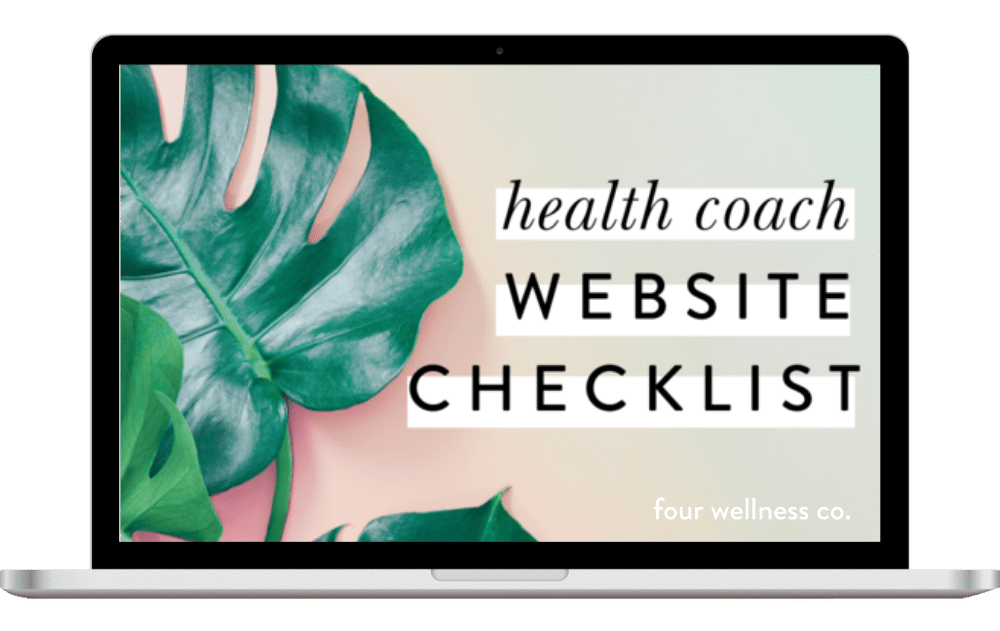The Best Ways to Market Your Health Coaching Business
This post contains affiliate links, through which we may earn a small commission if you choose to purchase, at no additional cost to you. We only share products or services we personally use & recommend!
In my experience, the same traits that make health coaches great at health coaching (empathy, desire to help others) also make us not-so-great at marketing and self-promotion. 😅
When I completed my health coaching certification from the Institute for Integrative Nutrition, and I started to build my health coaching business… I hated anything to do with marketing myself.
Having to say “Hey, this is who I am, this is what I do, and this is how I can help you” felt awkward and imposing, and I certainly didn’t want to push my business, my ideas or my services on anyone.
Fast forward a few years and I can tell you: without marketing yourself effectively, you have no business. (And this is especially true for health coaches looking to do online coaching.)
Marketing your health coaching services clearly and effectively to your target audience is one of the most important aspects of growing a successful online health coaching business.
While networking and referrals can be a great option for local marketing and in-person business models, here is a method I’ve found much more effective for marketing online health coaching programs and services:
blogging + Pinterest + email marketing = 😍
Let’s chat through each step of this equation and how it all adds up to growing an interested audience of potential customers for your health coaching or wellness business:
How to market your health coaching business
There are three primary steps that work together to market your health coaching business and build a targeted audience of interested, potential customers for you: blogging (content creation), Pinterest (content marketing), and email marketing (email list growth and management). Here’s what to know about each step of the process:
1. Start a wellness blog
The very first step of our fancy little marketing equation is blogging, or content creation.
So, your first task in marketing your wellness business is to develop blog content on topics relevant to your health coaching practice and areas of expertise.
If you’re a generalized health coach, you’ll want to include a variety of topics to show the range of areas you work with: nutrition, fitness, mindset, etc. If your practice focuses on weight loss or women’s health, you’ll want your blog content to focus on those areas specifically.
It’s important that your blog content is directly relevant (and interesting!) to your target audience—the “ideal client” you’re hoping to attract to eventually purchase your business services.
Here are more details on how to start a wellness blog for your health coaching business.
What should my wellness blog posts be about?
Your health coaching areas of expertise! And, specifically, anything relevant to the health coaching services or wellness programs/products you provide.
The goal of your wellness blog is to create content that is super relevant and helpful to the exact people to whom you’d ultimately like to offer and sell your health coaching services.
How many blog posts do I need?
There’s no magic number of blog posts you need to begin an effective content marketing strategy (and, the best number for your particular needs will depend on the topic areas you’ll be including in your blog, how long and detailed your posts are, etc.).
That said, for most new health coaches, starting with at least six core blog posts for the next step should do the trick.
How long should my blog posts be?
Aim for 1,000 - 1,500 words. Long enough to be substantive with helpful content (and to help build meaningful SEO for your website), but digestible enough that your readers don’t trickle away before they receive your valuable content and reach your call-to-action or opt-in.
Have any tips for writing good wellness blog posts?
We sure do! Here’s a full post on how to attract your ideal health coaching clients with your blog content.
2. Promote your wellness blog content on Pinterest
Okay, so you have at least six quality wellness-related blog posts you’re ready to promote! The next step is to share them far and wide on Pinterest.
Pinterest is, hands-down, the best social platform for content marketing. It’s more of a visual search engine than a true social media network, and your content doesn’t disappear and become irrelevant with time—it actually continues to grow and gain traction as more people see and share (e.g. “pin”) it to their own networks.
For new businesses, particularly those in the health and wellness industry, it’s an invaluable tool for growing your website traffic.
To begin content marketing with Pinterest, you’ll want to sign up for a free Pinterest business account. This gives you the ability to:
claim your website on Pinterest (get the link and checkmark below your profile photo)
incorporate Rich Pins (which look more professional and carry along important metadata from your website)
access advanced analytics on how your pins are performing
run ads (promoted pins) to reach more people
Once you have your Pinterest business account profile set up, the next step is to create branded pins promoting your wellness blog posts, and add those pins (with strategic, keyword-rich descriptions) to relevant boards on Pinterest.
For more detail (and some helpful tips!) on each step of this process, we have an entire post on using Pinterest to promote your wellness blog content. But, to recap, here’s the gist of it:
→ Create branded pins promoting your wellness blog posts
Create branded pins that describe and promote each of your specific wellness-themed blog posts. You’ll need design software for this—I recommend Canva, which is super easy to use (and also offers a free plan!). Aim to create 2-4 unique pins for each blog post. You can see examples of our branded pins on our Pinterest account.
→ Write keyword-rich captions
For each pin, write a descriptive, keyword-rich caption. Don’t simply duplicate your blog post excerpt, which will be pulled in with the Rich Pin content you’ve enabled, but write supplemental text to accompany your pin, describe what it’s about, and help the Pinterest algorithm rank it properly in searches.
→ Upload to Pinterest
You can upload your pins directly to Pinterest… or you can use a scheduling tool that allows you to upload them in bulk, while scheduling them to be published at intervals (much better from an efficiency and algorithm standpoint). We use and recommend a Pinterest scheduling tool called Tailwind. Upload your pins to relevant boards—both your own boards, as well as any group boards you belong to.
And, voilà! Now you’ve got branded pins, linked to your blog posts, making their way around Pinterest and driving traffic to your health coaching website.
3. Turn your health coaching website visitors into email subscribers
As you start sharing your wellness blog content via Pinterest, you’ll begin receiving more website traffic from it.
When new visitors come to your health coaching website from Pinterest (primarily via the blog posts you’ve promoted), be sure you have a way that they can “stay a while” and continue to engage with your business. Aka, offer them an opportunity (or, opportunities, plural!) to sign up for your email list.
In some cases, people will be so enamored with your content that they’ll want to sign up for your email list without any special offer. But, often, visitors may not be jumping up and down at the prospect of joining yet another email list—but they’d be very interested in receiving a specific piece of helpful content you have to offer.
This is where you’ll use your health coaching opt-in gifts (also known as lead magnets or content upgrades) to encourage those visitors to stay around a bit longer and enjoy the valuable wellness content you have to offer.
Once you have people signing up for your mailing list (yay!), there are a few other pieces you’ll want to have in place for them:
Set up your new subscriber welcome automation
Your welcome automation is an email that’s automatically sent to new subscribers to confirm their subscription, welcome them to your list, let them know how often they can expect to hear from you, etc.
This is a great opportunity to highlight your specific areas of wellness expertise and show your personality—both important factors in ultimately working with someone as a health coach.
Here’s how to set up your welcome automation in Flodesk or Mailchimp.
Send regular wellness newsletters
Engaging your email list is an important way to keep your audience informed about your new wellness blog content and your health coaching offerings. But even more importantly: regular, helpful emails work to build rapport with your audience—which is super helpful down the road when you’re selling them a $$$ coaching program.
Here’s how to craft the perfect newsletter template for your business. It’s a good idea to stay in touch with your email subscribers by sending helpful and inspiring messages somewhere between weekly and monthly—whatever works for you as a comfortable balance between keeping your subscribers updated and inspired, without overwhelming them with too many messages.
Using these marketing strategies to grow your health coaching business
The content marketing strategy outlined above (blogging + Pinterest + email marketing) allows you to use your own existing wellness expertise to attract your ideal health coaching clients, build rapport with them, and engage them with your health coaching services.
To recap, here are the three steps:
Start a wellness blog and create valuable, helpful content of interest to your target audience
Promote your wellness blog posts via Pinterest
When people visit your website (by clicking through on your pins), offer opportunities to opt-in to your mailing list; then, nurture your mailing list to build rapport
Ultimately, when you’ve taken time to engage and build rapport with your audience, you can begin offering your paid health coaching services relevant to their needs.
Perfect your health coaching website
Grab my free checklist for optimizing your wellness website!
It’s got all the big picture must-haves (& all the important little details!) to make your health coach website shine. ✨







